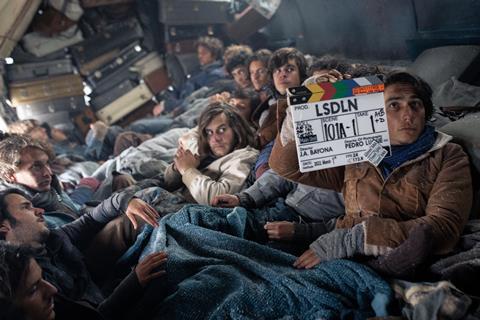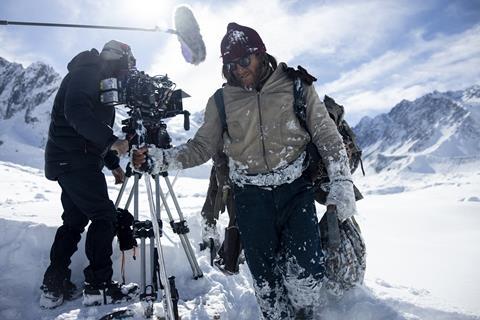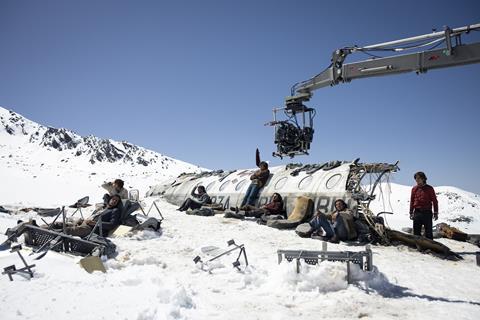Director JA Bayona describes how he doubled Spain’s Sierra Nevada mountain range for the Andes in his Oscar-nominated survival epic for Netflix.

As part of Spanish director JA Bayona’s research to film Society Of The Snow for Netflix, his adaptation of Pablo Vierci’s book of the same name about the 1972 Uruguayan rugby team whose plane crashed in the Argentinian Andes with horrifying consequences, the Spanish director visited the real-life crash site, the so-called Valley of the Tears in the Argentinian Andes.
“Reading the book, there is an image that made me realise how important the location was,” he explains. “A character, who isn’t in the film, had to talk in a press conference about what they did. He was so scared, but one of his teachers said, ‘if you tell them the context, they will understand.’ And to me, that line was very important.
“The first thing I did was travel to the Valley of Tears, and then I understood,” he continues. “You see how fascinating the location is. It’s one of the most important things in the story.”
However, shooting a feature film in the actual location was out of the question, even with the film’s reported €65m budget. “It’s impossible to shoot a movie there. It took us three days to get used to the altitude. You’d need a basecamp in a safe location, out of avalanches. It’s a dangerous place.”
Finding the Andes

Prior to principal photography, Bayona, cinematographer Pedro Luque, and visual effects supervisor Laura Pedro, spent four weeks in the Andes. They filmed a mix of helicopter perspectives using a Shotover gyro-stabilized platform, a DJI drone, and an Octocamvision Alta X quadcopter shooting with an Alexa and Panavision Super Speeds, with the help of US-based Benegas Brothers Productions. This allowed Luque to capture the dimensions and geography of the valley in all different kinds of lighting.
This work would be used later by the VFX team, including Félix Bergés, to recreate what it felt like to be there. At the time the mountains were completely bare, but luckily when Bayona and the team returned at the end of the shoot with Enzo Vogrincic, who plays Numa Turcatti, snow abounded and they were able to shoot scenes of the character looking for food.
Bayona and his team surveyed various alternatives to the inhospitable Valley of Tears: Swiss, French and Italian Alps, the Pyrenees, the Rocky Mountains in Canada and the US. The solution to the creative impasse was the Sierra Nevada mountains in Spain.
“It’s close to the equator, so it gives you more hours of daylight, and it’s more similar to the light in the Andes.”
The spot had another unique aspect: “It gave us the right geography for set extensions. It was like an amphitheatre with mountains in the back and a valley. It was more or less the same shape as the Valley of Tears. But when you see the shot in post-production, the mountains are bigger than the ones we had in the Sierra Nevada.”
Spain was also appealing from both financial and logistical perspectives: the country has a tax rebate of 30% for international film and TV productions, and the production could base itself as Netfilx’s Tres Cantos Madrid complex, working with local partners, El Arriero Films and Misión de Audaces Films
But while more feasible than The Valley of Tears, Sierra Nevada was still challenging. Three crash sites were built each with a plane; one at 3,000 metres in the Laguna de las Yeguas, a second at 2,000 metres in Pradollano, and a third in the parking lot of the Cortijo de la Argumosa ski resort in Güéjar Sierra at 1,000 metres.
They could only go up to the two higher elevation filming spots once per day, so forgetting things at base was not an option.
For the higher altitude shoots, they took a vehicle with space for 98 people. This had to accommodate not only the crew, but 25 of the 29 actors, including Vogrinic, whose Numa served as narrator, and Agustín Pardella and Matías Recalt, whose Nando Parrado and Roberto Canessa, respectively, hiked to find rescue after 79 days living in the mountains, among many more.
“We were like sardines in a can, heading up this steep mountain at seven in the morning. Everyone remained on site until the end of the shoot at 8.30, no matter how many or few scenes they were in.”
Plane simple

In the resort parking lot, in a portable warehouse from Belgium-based Spantech, special effects supervisor Pau Costa had the plane built on an hydraulic platform so it could be was buried in non-plastic artificial snow.
This studio had LED volume panels that gave Bayona a cover set for when they couldn’t shoot on location.
One such time occurred in April 2022. “I woke up one day and the mountain was orange.” This was due to the Calima Winds which swept dust from the Sahara to Sierra Nevada. “It looked like the desert in Lawrence Of Arabia. We had snow that covered it later, but every time there was a footprint, you would see orange below.”
This was fixed digitally in post-production. The production couldn’t simply shoot later scenes and return to the snowy mountains as the actors weight loss, strictly monitored by nutritionists, necessitated a chronological shoot. The last phase of production took place in Chile, where services were provided by Goodgate. In Madrid, Bayona’s team worked at Netflix’s Tres Cantos studios.
The production used a mainly Spanish crew, a familiar setup for Bayona even though Society of the Snow is his first Spanish-language film in 16 years. “Shooting with Spanish crews, it’s like a family, which has good things and bad things. A good thing, everything is more relaxed. A bad thing… everything is more relaxed.”
Bayona’s affection for his native-language crew is obvious. “From the beginning we established personal relationships. Every Saturday we’d go and have a party together, the crew and the actors. And that’s the difference, you won’t get that on an American production.”
Bayona’s familial work style broke through on his other productions. On Amazon’s The Lord Of The Rings- The Rings of Power for which he executive produced and directed the first two episodes, he took the crew to karaoke.
But Society Of The Snow’s remote location did not grant Bayona the opportunity for off-site frivolity. Everyone had a small taste of what the characters went through, “the cold, the hunger and the isolation.” Still, “Everybody has very fond memories of the shoot. It became an adventure. They had a lot of people surrounding them, and they became like a family.”
“The mountains were like the size of this table,” Bayona holds his hands over the four-foot coffee table. “And the plane was this,” he points to a spec of coffee on the inside of his mug. “I showed the actors: you are here.” To illustrate the vastness, Bayona had production designer Alain Bainée build a scale model.
To bring this vastness to the viewer, Bergés built digital set extensions in Unreal Engine. Plenty of previsualisation and post-production work went into transporting the audience to the Valley of Tears. For Bergés, “that is the most beautiful thing, that people think this was shot entirely in the Andes.”























No comments yet